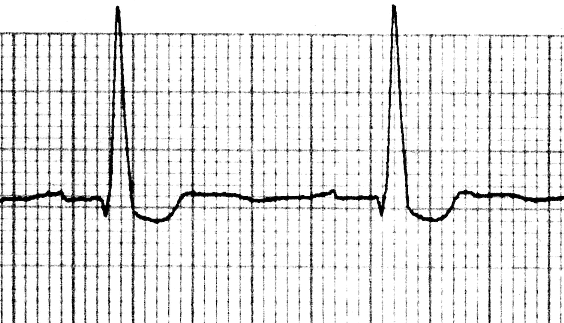Etiology
Digoxin toxicity can occur through a number of different mechanisms:
Acute
Overdose after suicide attempt
Medication dosing error
Malicious intent (homicidal poisoning).
Chronic
Chronic digoxin overmedication
Increased gastrointestinal absorption (caused by antibacterial therapy, or by drug-induced P-glycoprotein inhibition)[9][10][11]
Decreased renal clearance due to renal insufficiency or drugs[12][13][14][15][16]
Displacement of digoxin from protein-binding sites[12][13][15]
Conditions that increase susceptibility to digoxin (electrolyte abnormalities, e.g., hypokalemia, hypomagnesemia, hypercalcemia)[17][18]
Digoxin is largely dependent on p-glycoprotein for elimination. Thus, medications that inhibit p-glycoprotein may increase digoxin levels and potentially cause toxicity. These are numerous, but clinically significant ones include verapamil, diltiazem, amiodarone, quinidine, ketoconazole, itraconazole, vinblastine, doxorubicin, 2,4-dinitrophenol, and erythromycin. These substances may also inhibit cytochrome 3A4.[19] Others include clarithromycin, cyclosporine, propafenone, quinidine, and spironolactone.
Pathophysiology
Digoxin inhibits Na+/K+ ATPase. This increases cytosolic Ca, which increases inotropy. Abnormal sodium, potassium, or magnesium levels and acidosis increase toxicity by further depressing the Na+/K+ ATPase pump.
Therapeutically, digoxin increases automaticity and shortens the repolarization intervals of the atria and ventricles. There is a concurrent decrease in depolarization and conduction through the sinoatrial and atrioventricular (AV) nodes, respectively. These changes are reflected on the ECG by a decrease in ventricular response rate PR-interval prolongation, QT-interval shortening, and ST-segment and T-wave forces opposite the direction of the major QRS forces (scooped ST segment). This results in the characteristic digitalis effect.[20]
In overdose, digoxin produces two major effects that correlate with its therapeutic action:
Slowed conduction by increasing block at the AV node
Increased automatic triggered electrical activity in atrial muscle, the AV junction, the His-Purkinje system, and the ventricular muscle (increased automaticity)
Digoxin toxicity can also cause hyperkalemia, which increases the risk of dysrhythmias. Toxicity depends on intracellular levels and does not correlate well with serum levels. Noncardiac adverse effects may also be mediated by inhibition of Na+/K+ ATPase in other tissues.[21]
[Figure caption and citation for the preceding image starts]: ECG showing digoxin effectFrom the collection of Dr Robert S. Hoffman [Citation ends].
Classification
Acute toxicity: patients who take a digoxin overdose when they are not prescribed digoxin themselves (i.e., patients who take an accidental or intentional overdose when not already prescribed digoxin for an existing condition).
Acute on chronic toxicity: patients who are prescribed digoxin for an existing condition and take a digoxin overdose. Acute overdose in patients on regular therapy is expected to be more toxic than in patients who are not already taking therapeutic digoxin.
Chronic toxicity: patients who present with digoxin toxicity because of drug accumulation (commonly due to renal failure) without having taken an overdose.
Use of this content is subject to our disclaimer